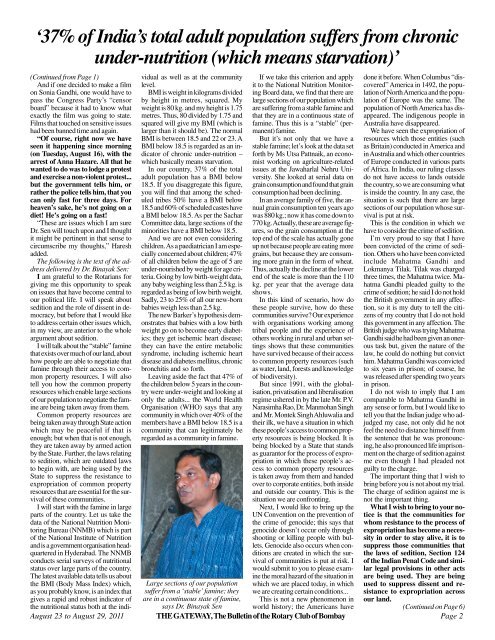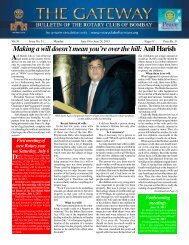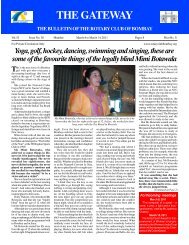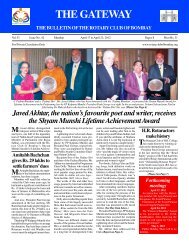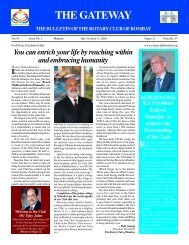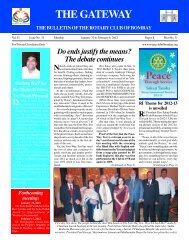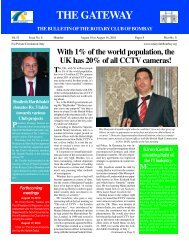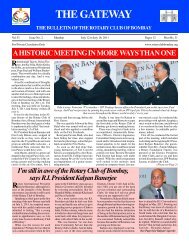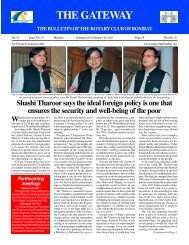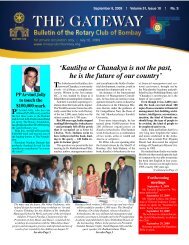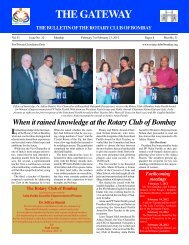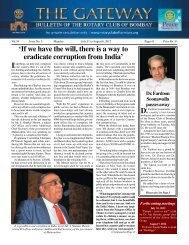Gateway 230811.pmd - Rotary Club of Bombay
Gateway 230811.pmd - Rotary Club of Bombay
Gateway 230811.pmd - Rotary Club of Bombay
You also want an ePaper? Increase the reach of your titles
YUMPU automatically turns print PDFs into web optimized ePapers that Google loves.
‘37% <strong>of</strong> India’s total adult population suffers from chronicunder-nutrition (which means starvation)’(Continued from Page 1)And if one decided to make a filmon Sonia Gandhi, one would have topass the Congress Party’s “censorboard” because it had to know whatexactly the film was going to state.Films that touched on sensitive issueshad been banned time and again.“Of course, right now we haveseen it happening since morning(on Tuesday, August 16), with thearrest <strong>of</strong> Anna Hazare. All that hewanted to do was to lodge a protestand exercise a non-violent protest...but the government tells him, orrather the police tells him, that youcan only fast for three days. Forheaven’s sake, he’s not going on adiet! He’s going on a fast!“These are issues which I am sureDr. Sen will touch upon and I thoughtit might be pertinent in that sense tocircumscribe my thoughts,” Hareshadded.The following is the text <strong>of</strong> the addressdelivered by Dr. Binayak Sen:I am grateful to the Rotarians forgiving me this opportunity to speakon issues that have become central toour political life. I will speak aboutsedition and the role <strong>of</strong> dissent in democracy,but before that I would liketo address certain other issues which,in my view, are anterior to the wholeargument about sedition.I will talk about the “stable” faminethat exists over much <strong>of</strong> our land, abouthow people are able to negotiate thatfamine through their access to commonproperty resources. I will alsotell you how the common propertyresources which enable large sections<strong>of</strong> our population to negotiate the famineare being taken away from them.Common property resources arebeing taken away through State actionwhich may be peaceful if that isenough; but when that is not enough,they are taken away by armed actionby the State. Further, the laws relatingto sedition, which are outdated lawsto begin with, are being used by theState to suppress the resistance toexpropriation <strong>of</strong> common propertyresources that are essential for the survival<strong>of</strong> these communities.I will start with the famine in largeparts <strong>of</strong> the country. Let us take thedata <strong>of</strong> the National Nutrition MonitoringBureau (NNMB) which is part<strong>of</strong> the National Institute <strong>of</strong> Nutritionand is a government organisation headquarteredin Hyderabad. The NNMBconducts serial surveys <strong>of</strong> nutritionalstatus over large parts <strong>of</strong> the country.The latest available data tells us aboutthe BMI (Body Mass Index) which,as you probably know, is an index thatgives a rapid and robust indicator <strong>of</strong>the nutritional status both at the individualas well as at the communitylevel.BMI is weight in kilograms dividedby height in metres, squared. Myweight is 80 kg. and my height is 1.75metres. Thus, 80 divided by 1.75 andsquared will give my BMI (which islarger than it should be). The normalBMI is between 18.5 and 22 or 23. ABMI below 18.5 is regarded as an indicator<strong>of</strong> chronic under-nutrition –which basically means starvation.In our country, 37% <strong>of</strong> the totaladult population has a BMI below18.5. If you disaggregate this figure,you will find that among the scheduledtribes 50% have a BMI below18.5 and 60% <strong>of</strong> scheduled castes havea BMI below 18.5. As per the SacharCommittee data, large sections <strong>of</strong> theminorities have a BMI below 18.5.And we are not even consideringchildren. As a paediatrician I am especiallyconcerned about children; 47%<strong>of</strong> all children below the age <strong>of</strong> 5 areunder-nourished by weight for age criteria.Going by low birth-weight data,any baby weighing less than 2.5 kg. isregarded as being <strong>of</strong> low birth weight.Sadly, 23 to 25% <strong>of</strong> all our new-bornbabies weigh less than 2.5 kg.The new Barker’s hypothesis demonstratesthat babies with a low birthweight go on to become early diabetics;they get ischemic heart disease;they can have the entire metabolicsyndrome, including ischemic heartdisease and diabetes mellitus, chronicbronchitis and so forth.Leaving aside the fact that 47% <strong>of</strong>the children below 5 years in the countrywere under-weight and looking atonly the adults... the World HealthOrganisation (WHO) says that anycommunity in which over 40% <strong>of</strong> themembers have a BMI below 18.5 is acommunity that can legitimately beregarded as a community in famine.Large sections <strong>of</strong> our populationsuffer from a ‘stable’ famine; theyare in a continuous state <strong>of</strong> famine,says Dr. Binayak SenIf we take this criterion and applyit to the National Nutrition MonitoringBoard data, we find that there arelarge sections <strong>of</strong> our population whichare suffering from a stable famine andthat they are in a continuous state <strong>of</strong>famine. Thus this is a “stable” (permanent)famine.But it’s not only that we have astable famine; let’s look at the data setforth by Ms Utsa Pattnaik, an economistworking on agriculture-relatedissues at the Jawaharlal Nehru University.She looked at serial data ongrain consumption and found that grainconsumption had been declining.In an average family <strong>of</strong> five, the annualgrain consumption ten years agowas 880 kg.; now it has come down to770 kg. Actually, these are average figures,so the grain consumption at thetop end <strong>of</strong> the scale has actually goneup not because people are eating moregrains, but because they are consumingmore grain in the form <strong>of</strong> wheat.Thus, actually the decline at the lowerend <strong>of</strong> the scale is more than the 110kg. per year that the average datashows.In this kind <strong>of</strong> scenario, how dothese people survive, how do thesecommunities survive? Our experiencewith organisations working amongtribal people and the experience <strong>of</strong>others working in rural and urban settingsshows that these communitieshave survived because <strong>of</strong> their accessto common property resources (suchas water, land, forests and knowledge<strong>of</strong> biodiversity).But since 1991, with the globalisation,privatisation and liberalisationregime ushered in by the late Mr. P.V.Narasimha Rao, Dr. Manmohan Singhand Mr. Montek Singh Ahluwalia andtheir ilk, we have a situation in whichthese people’s access to common propertyresources is being blocked. It isbeing blocked by a State that standsas guarantor for the process <strong>of</strong> expropriationin which these people’s accessto common property resourcesis taken away from them and handedover to corporate entities, both insideand outside our country. This is thesituation we are confronting.Next, I would like to bring up theUN Convention on the prevention <strong>of</strong>the crime <strong>of</strong> genocide; this says thatgenocide doesn’t occur only throughshooting or killing people with bullets.Genocide also occurs when conditionsare created in which the survival<strong>of</strong> communities is put at risk. Iwould submit to you to please examinethe moral hazard <strong>of</strong> the situation inwhich we are placed today, in whichwe are creating certain conditions...This is not a new phenomenon inworld history; the Americans havedone it before. When Columbus “discovered”America in 1492, the population<strong>of</strong> North America and the population<strong>of</strong> Europe was the same. Thepopulation <strong>of</strong> North America has disappeared.The indigenous people inAustralia have disappeared.We have seen the expropriation <strong>of</strong>resources which those entities (suchas Britain) conducted in America andin Australia and which other countries<strong>of</strong> Europe conducted in various parts<strong>of</strong> Africa. In India, our ruling classesdo not have access to lands outsidethe country, so we are consuming whatis inside the country. In any case, thesituation is such that there are largesections <strong>of</strong> our population whose survivalis put at risk.This is the condition in which wehave to consider the crime <strong>of</strong> sedition.I’m very proud to say that I havebeen convicted <strong>of</strong> the crime <strong>of</strong> sedition.Others who have been convictedinclude Mahatma Gandhi andLokmanya Tilak. Tilak was chargedthree times, the Mahatma twice. MahatmaGandhi pleaded guilty to thecrime <strong>of</strong> sedition; he said I do not holdthe British government in any affection,so it is my duty to tell the citizens<strong>of</strong> my country that I do not holdthis government in any affection. TheBritish judge who was trying MahatmaGandhi said he had been given an oneroustask but, given the nature <strong>of</strong> thelaw, he could do nothing but convicthim. Mahatma Gandhi was convictedto six years in prison; <strong>of</strong> course, hewas released after spending two yearsin prison.I do not wish to imply that I amcomparable to Mahatma Gandhi inany sense or form, but I would like totell you that the Indian judge who adjudgedmy case, not only did he notfeel the need to distance himself fromthe sentence that he was pronouncing,he also pronounced life imprisonmenton the charge <strong>of</strong> sedition againstme even though I had pleaded notguilty to the charge.The important thing that I wish tobring before you is not about my trial.The charge <strong>of</strong> sedition against me isnot the important thing.What I wish to bring to your noticeis that the communities forwhom resistance to the process <strong>of</strong>expropriation has become a necessityin order to stay alive, it is tosuppress those communities thatthe laws <strong>of</strong> sedition, Section 124<strong>of</strong> the Indian Penal Code and similarlegal provisions in other actsare being used. They are beingused to suppress dissent and resistanceto expropriation acrossour land.(Continued on Page 6)August 23 to August 29, 2011 THE GATEWAY, The Bulletin <strong>of</strong> the <strong>Rotary</strong> <strong>Club</strong> <strong>of</strong> <strong>Bombay</strong> Page 2


